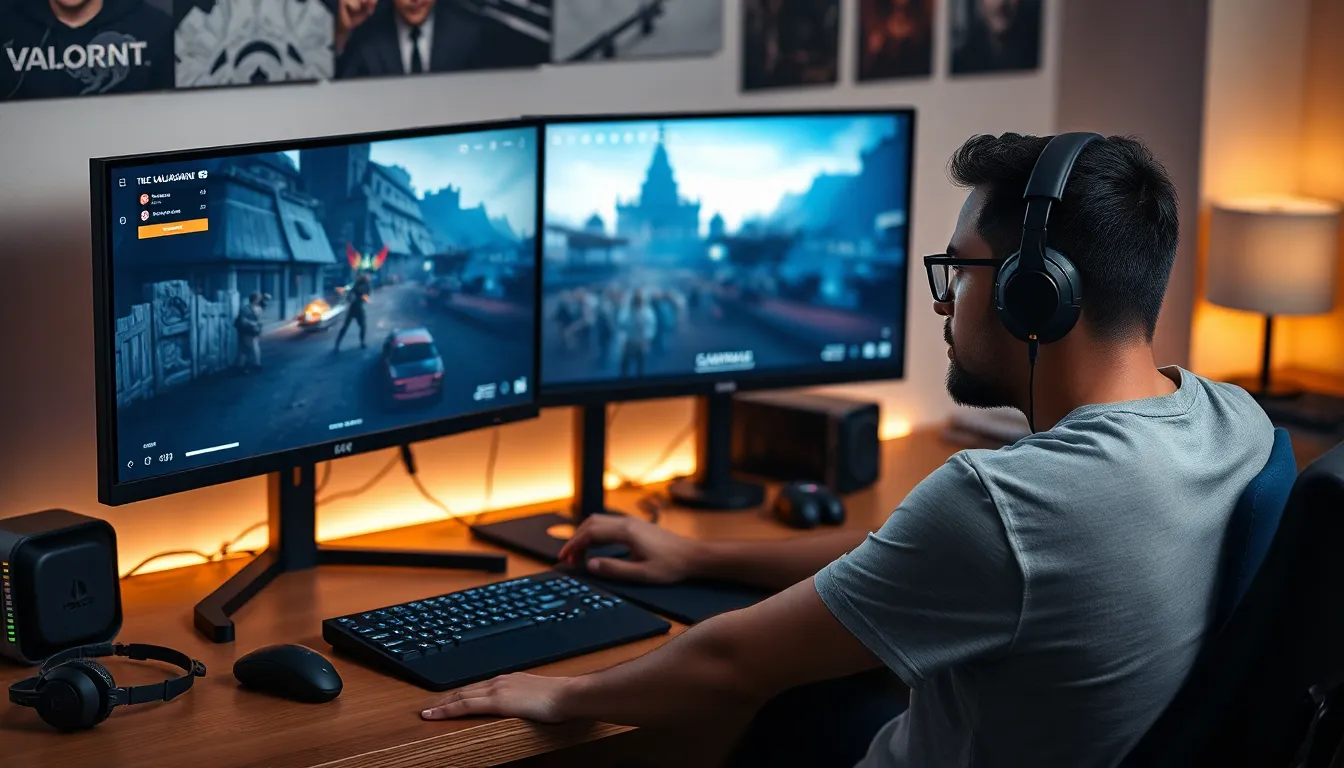Table of Contents
ToggleIn the competitive world of VALORANT, understanding the nuances of each match can be the difference between victory and defeat. Players and analysts alike dive deep into match analysis to uncover strategies, player performance, and map dynamics that define the outcome. This analytical approach not only enhances individual skills but also fosters team synergy, making it essential for aspiring professionals and casual gamers.
As teams battle it out in this tactical shooter, dissecting gameplay elements such as agent selection, positioning, and communication becomes crucial. By examining these aspects, players can adapt their strategies and improve their overall game. Whether you’re a newcomer eager to learn or a seasoned player looking to refine your skills, mastering match analysis is key to climbing the ranks in VALORANT.
Overview of VALORANT Match Analysis
VALORANT match analysis involves examining various gameplay aspects to enhance performance and strategy. Key focuses include strategies, player performance, and map dynamics. Analyzing these elements helps players identify strengths and weaknesses, leading to informed decisions.
Critical Elements of Match Analysis
- Agent Selection: The choice of agents plays a crucial role in team composition and strategy. Understanding the synergies between agents can optimize team effectiveness.
- Positioning: Effective positioning dictates the flow of combat in different scenarios. Assessing positioning during previous matches helps players learn optimal locations for attack or defense.
- Communication: Strong communication among teammates fosters better coordination and efficiency. Analyzing communication patterns can identify areas for improvement.
- Map Dynamics: Each map has unique features that influence gameplay. Analyzing map layouts, choke points, and common strategies aids in developing counter-strategies.
- Economy Management: Understanding in-game economics, including buying and saving strategies, affects overall team performance. Assessment of economic decisions from past matches can lead to more effective in-game resource management.
By focusing on these elements, players enhance their understanding of VALORANT, fostering improved teamwork and individual skills. Match analysis serves as a vital tool for continuous improvement in this competitive landscape.
Key Components of VALORANT Match Analysis

Analyzing matches in VALORANT involves examining critical components that influence team performance and individual skills. Focusing on player performance metrics and tactical team strategies enhances understanding and execution of gameplay.
Player Performance Metrics
Player performance metrics consist of several key statistics that directly reflect a player’s effectiveness. Common metrics include:
- Kill/Death Ratio (K/D): Measures the balance between kills and deaths, indicating a player’s efficiency in combat.
- Average Damage per Round (ADR): Assesses damage dealt relative to the number of rounds played, showing how impactful a player is in engagements.
- Spike Plants and Defuses: Tracks involvement in key objectives, emphasizing a player’s contribution to round wins.
- Utility Usage: Evaluates how well players utilize their agents’ abilities to control the battlefield and support teammates.
- Round Impact: Analyzes crucial moments where a player made defining plays, contributing to the team’s victory or preventing a loss.
These metrics help coaches and players identify strengths and areas for improvement, allowing for data-driven enhancements in gameplay.
Tactical Team Strategies
Tactical team strategies hinge on coordinated efforts and effective communication among players. Essential elements include:
- Agent Composition: Balancing roles such as Controllers, Duelists, Sentinels, and Initiators to ensure diverse capabilities within the team.
- Site Execution: Implementing tactics for attacking or defending bomb sites, focusing on positioning and utility deployment.
- Map Control: Securing critical areas to establish dominance, influencing enemy movement and decision-making.
- Adaptation Flexibility: Adjusting strategies based on the opposing team’s play style and composition, ensuring optimum responses to changing situations.
- Communication and Callouts: Using clear and consistent communication to relay information about enemy locations, abilities, and strategies.
By meticulously analyzing these tactical elements, players can refine their approach, improving their chances of success in competitive matches.
Tools and Resources for Analysis
VALORANT match analysis benefits from a variety of tools and resources that assist players in evaluating their performance and strategies. These tools enhance the overall understanding of gameplay dynamics.
Utilizing In-Game Stats
In-game stats offer players immediate insights into their performance. Metrics such as Kill/Death Ratio (K/D), Average Damage per Round (ADR), and Ability Usage can be accessed through the game’s built-in scoreboard. Players should regularly review these statistics to identify personal strengths and weaknesses during matches. For example, a low K/D may indicate the need for improved positioning, while low ability usage could suggest a lack of strategic execution. Consistently tracking these in-game stats informs players about which areas to focus on for improvement.
Third-Party Analytics Platforms
Third-party analytics platforms provide comprehensive data analysis and performance breakdowns that complement in-game statistics. Platforms like Tracker Network and Overwolf aggregate detailed performance metrics and gameplay patterns. These services enable players to dissect match histories and evaluate team compositions. For instance, utilizing these platforms helps players identify trends in their gameplay, such as preferred agents or successful strategies. By leveraging third-party analytics, players can make data-driven decisions that enhance their preparation and overall competitive edge in VALORANT.
Common Mistakes in VALORANT Match Analysis
Identifying common mistakes in VALORANT match analysis can aid players and teams in improving their strategies and performance. These errors often stem from a lack of focus on key gameplay elements and improper interpretation of data.
- Ignoring Personal Performance Metrics: Relying solely on team statistics can obscure individual player areas for growth. Tracking metrics like Kill/Death Ratio (K/D) and Average Damage per Round (ADR) ensures players recognize their contributions and shortcomings.
- Overlooking Map Dynamics: Failing to analyze map-specific strategies can lead to ineffective gameplay. Understanding choke points, sightlines, and favored angles can enhance positioning and decision-making during matches.
- Neglecting Agent Synergy: Disregarding the importance of agent composition often results in unbalanced teams. Ensuring agents complement each other’s abilities can maximize utility during engagements and site takes.
- Misinterpreting Communication Dynamics: Miscommunication or lack of communication can disrupt team cohesion. Analyzing communication during matches helps identify lapses, allowing for improvements in callouts and information sharing.
- Forgetting About In-Game Economy Management: Failing to comprehend economic dynamics can hinder team performance. Analyzing buy phases and saving strategies fosters smarter financial decisions that impact match outcomes.
- Focusing on Short-Term Wins Instead of Long-Term Growth: Concentrating solely on immediate match results can obscure broader learning opportunities. Focusing on long-term skill development and refining strategies through analysis leads to sustained improvement.
- Not Using Analytical Tools Effectively: Underutilizing in-game stats and third-party platforms limits understanding of gameplay trends. Leveraging analytics tools can provide insights that enhance tactical approaches and performance assessments.
Addressing these common mistakes enables VALORANT players to refine their match analysis techniques, leading to improved gameplay and increased success in competitive environments. By focusing on performance metrics, understanding map dynamics, and utilizing tools effectively, players enhance their overall analysis process.
Mastering VALORANT match analysis is vital for players striving for improvement and success. By focusing on key elements like agent selection and communication players can develop strategies that enhance both individual and team performance.
Utilizing in-game stats and third-party tools allows for deeper insights into gameplay and fosters informed decision-making. Addressing common mistakes in analysis ensures a more effective approach to gameplay.
With dedication to understanding these components players can elevate their skills and navigate the competitive landscape with confidence.





